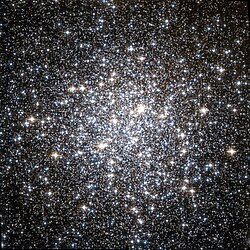| NGC 6723 | |
|---|---|
 NGC 6723 by Hubble Space Telescope; 3.5′ view | |
| Observation data (J2000 epoch) | |
| Class | VII [1] |
| Constellation | Sagittarius |
| Right ascension | 18h 59m 33.15s [2] |
| Declination | –36° 37′ 56.1″ [2] |
| Distance | 28.4 kly (8.7 kpc) [3] |
| Apparent magnitude (V) | 6.8 [4] |
| Apparent dimensions (V) | 11′ [4] |
| Physical characteristics | |
| Mass | 3.57×105 [3] M☉ |
| Metallicity | = –0.96 [5] dex |
| Estimated age | 13.06 Gyr [5] |
NGC 6723, also known as the Chandelier Cluster, [6] is a globular cluster [7] in the constellation Sagittarius. Its magnitude is given as between 6 and 6.8, and its diameter is between 7 and 11 arcminutes. It is a class VII cluster with stars of magnitude 14 and dimmer. It is near the border of Sagittarius and Corona Australis.
Unlike common globular clusters, NGC 6723 has an enhanced metallicity and a large fraction of younger stars, with primordial stars accounting for only 0.363±0.017 % of the total. [8]

